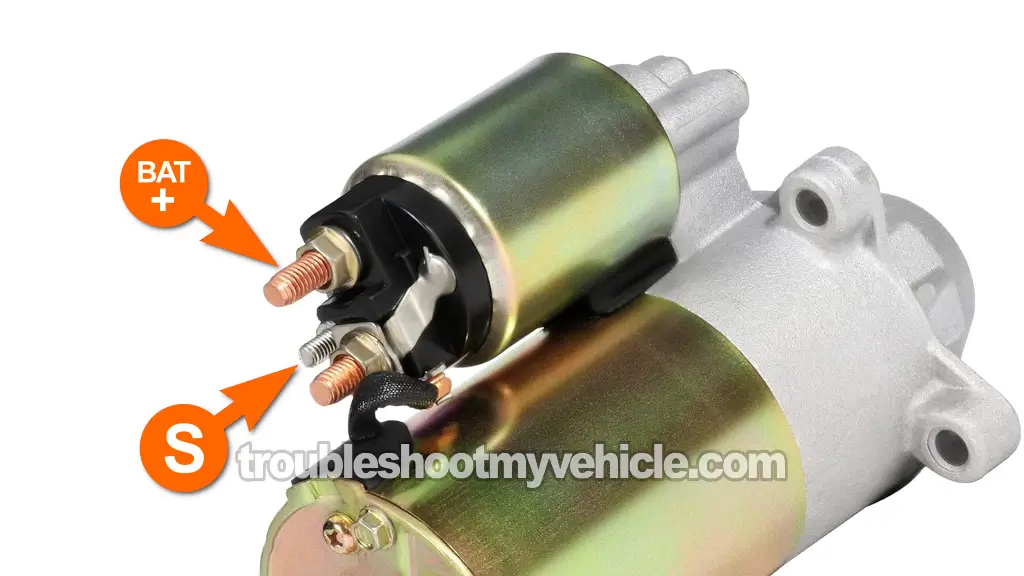TEST 2: Verifying The 12 Volt Start Signal

If you've confirmed that applying 12 Volts directly to the solenoid's S terminal engages the starter motor and cranks the engine (TEST 1), our next step is to check if the starter is receiving the 12 Volt signal from the ignition switch when you turn the key.
To check for the presence of this activation signal, we'll use a multimeter to measure the voltage at the S terminal.
It's important to note that the 12 Volt activation signal should only be present at the S terminal when the key is turned to the "START" position.
NOTE: You can perform this test with the S wire connected or disconnected to the S terminal.
These are the test steps:
- 1
Raise and place the front of the vehicle on jack stands (if it isn't already).
- 2
Place your multimeter in Volts DC mode.
- 3
Ground the black multimeter test lead directly on the negative (-) battery terminal using a jump start cable.
You can also Ground it on the engine, if you can find a clean, unpainted and rust-free spot of metal. - 4
Connect the red multimeter test lead to the S terminal wire using an appropriate tool.
Don't know which wire is the S terminal wire? It's the one that connects to the smaller of the three studs on the starter motor solenoid.
The S terminal wire (circuit) is the one that delivers the Start (Crank) signal from the ignition switch. - 5
Have your helper turn the key to crank the engine when the test is setup.
- 6
Your multimeter should read 10 to 12 Volts DC.
OK, let's take a look at your test result:
CASE 1: The wire is delivering 10 to 12 Volts when you turn the key to crank the engine. This is the correct test result and confirms that the starter motor is receiving an activation signal.
Your next and final test is: TEST 3: Voltage Drop Testing The Battery (+) Cable.
CASE 2: The wire IS NOT delivering 10 to 12 Volts when you turn the key to crank the engine. This test result confirms the starter motor isn't receiving an activation signal. Without it, the starter motor will not activate and crank the engine.
The missing starter motor activation signal is most likely caused by one of the following issues:
- A bad starter motor relay.
- A bad park-neutral safety switch (automatic transmission).
- A bad clutch pedal switch (manual transmission).
- A bad ignition switch.
- An anti-theft system fault (if equipped).
Although it's beyond the scope of this tutorial, your next step is to find the cause of the missing activation signal and resolve the issue.
TEST 3: Voltage Drop Testing The Battery (+) Cable

The starter motor requires quite a bit of current to crank the engine, and it all comes directly from your Crown Vic or Grand Marquis' battery.
The thickest cable connected to the starter motor carries this high current from the battery and connects to the large stud labeled 'BAT +' on the starter solenoid (see image above).
Over time, this cable can develop corrosion at its connection points, where it connects to the battery and the starter. This corrosion often appears as a white, green, or blue crusty buildup, but it can also be hidden within the connection itself.
Regardless of the amount of corrosion, it creates resistance in the cable and reduces the voltage reaching the starter motor, leading to a voltage drop.
To determine if a voltage drop in the cable is causing the starter motor failure, we can use a multimeter to perform a voltage drop test. This test will be the focus of this section.
Let's get going:
- 1
Place your multimeter in Volts DC mode.
- 2
Attach the red multimeter test lead to the positive (+) battery post. The positive (+) battery post must be clean and corrosion-free.
You may need two helpers for this test step, since someone will have to hold the red multimeter test lead onto the battery positive (+) post and someone else inside the vehicle (to crank it when everything is set up). - 3
Place the black multimeter test lead on the starter motor solenoid stud that connects to the battery positive (+) cable (see illustration above).
The orange arrow with the plus (+) sign, in the illustration above, points to this stud.
Maintain the black multimeter test lead in this position throughout the next step. - 4
When everything is ready, have your helper turn the key to crank the engine.
Although the starter motor won't crank the engine, your helper has to turn the ignition switch to start the engine for the voltage drop test to work. - 5
The multimeter should register 0.5 Volts or less (0.5 V = 0 Volts).
If there's a problem in the wire, your multimeter will register some voltage, usually 5 Volts or more.
Let's interpret your test result:
CASE 1: Your multimeter indicated NO voltage drop (0.5 Volts or less). This is the correct test result, and it confirms the starter motor is receiving all of the battery voltage and amperage it needs to crank the engine.
You can conclude that the starter motor is bad and needs replacement if you have:
- Confirmed that the starter motor does not crank the engine when you directly apply 12 Volts to the starter's S terminal (TEST 1).
- Confirmed, in this test section, that the battery positive (+) cable does not have a voltage drop issue.
Now, before you remove the starter motor, do two more important things:
- Confirm the starter motor is receiving an activation signal. TEST 2 will help you with this.
- Check that the engine is NOT mechanically locked up by manually turning it via its crankshaft pulley bolt (using a 1/2" ratchet and the appropriate size socket).
If you'd like to bench-test the starter motor (after removing it). You can find the step-by-step instructions here:
CASE 2: Your multimeter registered 5 Volts or more. This result confirms that the starter's battery (+) cable has corrosion on one or both terminal ends.
The issue causing the voltage drop in the cable will prevent the battery's total amperage output from reaching the starter motor.
Your next step is thoroughly cleaning both ends of the battery positive (+) cable with a small piece of sandpaper.
Eliminating the cause of the voltage drop should get the starter motor to crank the engine.
More 4.6L Crown Vic And Grand Marquis Tutorials
There are quite a few 4.6L Ford Crown Victoria (Mercury Grand Marquis) 'how to' tutorials and wiring diagrams in this index:
E-Series Vans: You can find all of the available tutorials and wiring diagrams for the 4.6L and 5.4L V8 E-Series vans in this index:
F-Series Pickups: You can find all of the available tutorials and wiring diagrams for the 4.6L And 5.4L V8 F-Series pickups in this index:
- 4.6L, 5.4L Ford F150, F250, And F350 Index of Articles (at: easyautodiagnostics.com.com).

If this info saved the day, buy me a beer!

